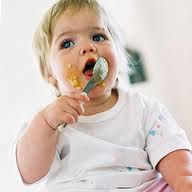| Child’s Age |
Mastered Skills (most kids can do) |
Emerging Skills (half of kids can do)
|
Advanced Skills (a few kids can do)
|
| 19 months |
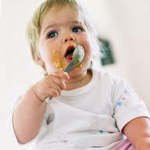 Uses a spoon and fork Uses a spoon and fork
Runs
Throws a ball underhand
Enjoys helping around the house
|
Understands as many as 200 words
Recognizes when something is wrong (e.g., calling a dog a cat)
|
Washes and dries own hands with help
Points to picture or object when you call it by name
May know when she needs to pee
|
| 20 months |
Feeds doll
Takes off own clothes
Dumps an object in imitation, such as throwing garbage away
|
Learns words at a rate of ten or more a day
Can walk up stairs (but probably not down)
|
May start exploring genitals
Draws a straight line
Names several body parts
|
| 21 months |
Can walk up stairs
Able to set simple goals (e.g., deciding to put a toy in a certain place)
|
Throws a ball overhand
Kicks ball forward
Stacks six blocks |
Names simple picture in a book
Can walk down stairs |
| 22 months |
Kicks ball forward
Follows two-step requests (e.g., “Get your doll and bring it here”)
|
Does simple puzzles
Draws a straight line
Names several body parts
|
Puts on loose-fitting clothes
Might be ready for a big bed
Understands opposites (e.g., tall vs. short)
|
| 23 months |
Names simple picture in a book
Uses 50 to 70 words |
Opens doors
Sings simple tunes
Takes more of an interest in playing with other kids
|
Talks about self  (likes, dislikes)
Asks “why?”
|
| 24 months |
Names at least six body parts
Half of speech is understandable
Makes two- to three-word sentences
|
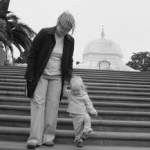 Talks about self Talks about self
Arranges things in categories
Can walk down stairs
|
Begins to understand abstract concepts (e.g., sooner and later)
Becomes attuned to gender differences
Learns to jump
|
| 25 and 26 months |
Stacks six blocks
Walks with smooth heel-to-toe motion
|
Uses pronouns (e.g., I, me, you)
Washes and dries own hands
|
Speaks clearly most of the time
Draws a vertical line
|
| 27 and 28 months |
Jumps with both feet
Opens doors
|
Understands descriptions (e.g., big, soft)
Draws a vertical line
|
Starts to recognize ABCs
Balances on one foot
|
| 29 and 30 months |
Brushes teeth with help
Washes and dries own hands
Draws a vertical line
|
Draws a circle
Balances on one foot
|
Puts on a T-shirt
Names one color
Names one friend
|
| 31 and 32 months |
Recites own name
Draws a circle
|
Puts on a T-shirt
Balances on each foot for a second
Recognizes ABCs
Brushes teeth by herself
|
Uses two adjectives
Draws a cross
Points to objects described by use
|
| 33 and 34 months |
Names one color
Names one friend
Carries on a simple conversation
|
Alternates feet going up and down stairs
Uses prepositions (e.g., on, in, over)
Speaks clearly most of the time (75 percent can be understood)
Stacks eight blocks
|
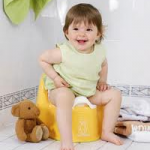 Is toilet trained during the day Is toilet trained during the day
Wiggles thumb
Expresses a wide range of emotions
Draws a stick figure
|
| 35 and 36 months |
Describes how two objects are used
Uses three to four words in a sentence
Names two actions (e.g., skipping, jumping)
|
Hops and skips
Follows a two- or three-part command
Separates fairly easily from parents
Rides a tricycle
|
Balances on each foot for three seconds
Gets dressed without help
|
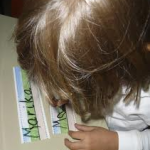 Cognitive
Cognitive